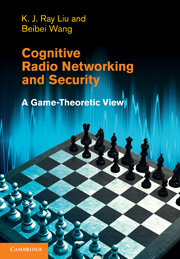Book contents
- Frontmatter
- Contents
- Preface
- Part I Cognitive radio communications and cooperation
- Part II Resource awareness and learning
- Part III Securing mechanism and strategies
- 15 Trust modeling and evaluation
- 16 Defense against routing disruptions
- 17 Defense against traffic-injection attacks
- 18 Stimulation of attack-resistant cooperation
- 19 Optimal strategies for stimulation of cooperation
- 20 Belief evaluation for cooperation enforcement
- 21 Defense against insider attacks
- 22 Secure cooperation stimulation under noise and imperfect monitoring
- References
- Index
15 - Trust modeling and evaluation
from Part III - Securing mechanism and strategies
Published online by Cambridge University Press: 06 December 2010
- Frontmatter
- Contents
- Preface
- Part I Cognitive radio communications and cooperation
- Part II Resource awareness and learning
- Part III Securing mechanism and strategies
- 15 Trust modeling and evaluation
- 16 Defense against routing disruptions
- 17 Defense against traffic-injection attacks
- 18 Stimulation of attack-resistant cooperation
- 19 Optimal strategies for stimulation of cooperation
- 20 Belief evaluation for cooperation enforcement
- 21 Defense against insider attacks
- 22 Secure cooperation stimulation under noise and imperfect monitoring
- References
- Index
Summary
The performance of distributed networks depends on collaboration among distributed entities. To enhance security in distributed networks, such as ad hoc networks, it is important to evaluate the trustworthiness of participating entities since trust is the major driving force for collaboration. In this chapter, we present a framework to quantitatively measure trust, model trust propagation, and defend trust-evaluation systems against malicious attacks. In particular, we address the fundamental understanding of trust, quantitative trust metrics, mathematical properties of trust, dynamic properties of trust, and trust models. The attacks against trust evaluation are identified and defense techniques are developed.
Introduction
The fields of computing and communications are progressively heading toward systems of distributed entities. In the migration from traditional architectures to more distributed architectures, one of the most important challenges is security.
Currently, the networking community is working on introducing traditional security services, such as confidentiality and authentication, into distributed networks including ad hoc networks and sensor networks. However, it has also recently been recognized that new tools, beyond conventional security services, need to be developed in order to defend these distributed networks from misbehavior and attacks that may be launched by selfish and malicious entities. In fact, the very challenge of securing distributed networks comes from the distributed nature of these networks – there is an inherent reliance on collaboration between network participants in order to achieve the planned functionalities.
- Type
- Chapter
- Information
- Cognitive Radio Networking and SecurityA Game-Theoretic View, pp. 373 - 398Publisher: Cambridge University PressPrint publication year: 2010



